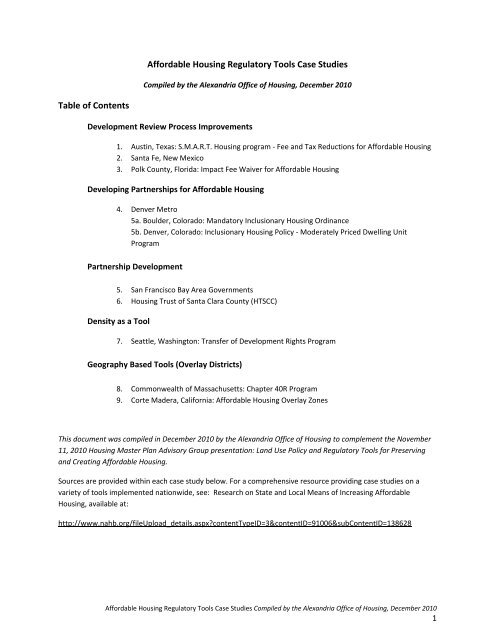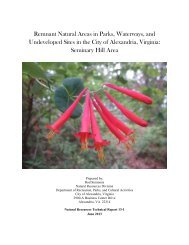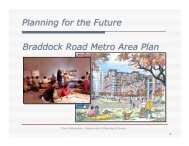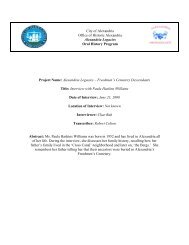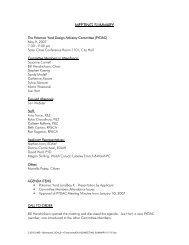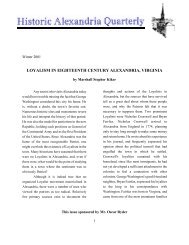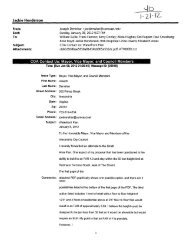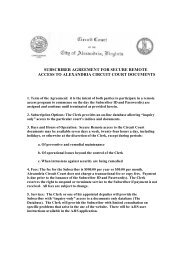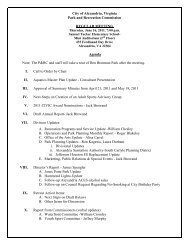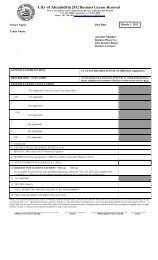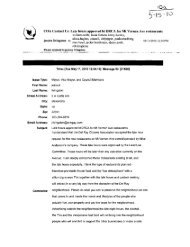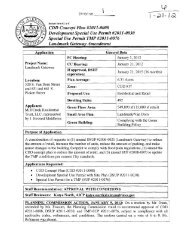Case Studies - Affordable Housing Regulatory ... - City of Alexandria
Case Studies - Affordable Housing Regulatory ... - City of Alexandria
Case Studies - Affordable Housing Regulatory ... - City of Alexandria
You also want an ePaper? Increase the reach of your titles
YUMPU automatically turns print PDFs into web optimized ePapers that Google loves.
Table <strong>of</strong> Contents<br />
<strong>Affordable</strong> <strong>Housing</strong> <strong>Regulatory</strong> Tools <strong>Case</strong> <strong>Studies</strong><br />
Compiled by the <strong>Alexandria</strong> Office <strong>of</strong> <strong>Housing</strong>, December 2010<br />
Development Review Process Improvements<br />
1. Austin, Texas: S.M.A.R.T. <strong>Housing</strong> program ‐ Fee and Tax Reductions for <strong>Affordable</strong> <strong>Housing</strong><br />
2. Santa Fe, New Mexico<br />
3. Polk County, Florida: Impact Fee Waiver for <strong>Affordable</strong> <strong>Housing</strong><br />
Developing Partnerships for <strong>Affordable</strong> <strong>Housing</strong><br />
4. Denver Metro<br />
5a. Boulder, Colorado: Mandatory Inclusionary <strong>Housing</strong> Ordinance<br />
5b. Denver, Colorado: Inclusionary <strong>Housing</strong> Policy ‐ Moderately Priced Dwelling Unit<br />
Program<br />
Partnership Development<br />
5. San Francisco Bay Area Governments<br />
6. <strong>Housing</strong> Trust <strong>of</strong> Santa Clara County (HTSCC)<br />
Density as a Tool<br />
7. Seattle, Washington: Transfer <strong>of</strong> Development Rights Program<br />
Geography Based Tools (Overlay Districts)<br />
8. Commonwealth <strong>of</strong> Massachusetts: Chapter 40R Program<br />
9. Corte Madera, California: <strong>Affordable</strong> <strong>Housing</strong> Overlay Zones<br />
This document was compiled in December 2010 by the <strong>Alexandria</strong> Office <strong>of</strong> <strong>Housing</strong> to complement the November<br />
11, 2010 <strong>Housing</strong> Master Plan Advisory Group presentation: Land Use Policy and <strong>Regulatory</strong> Tools for Preserving<br />
and Creating <strong>Affordable</strong> <strong>Housing</strong>.<br />
Sources are provided within each case study below. For a comprehensive resource providing case studies on a<br />
variety <strong>of</strong> tools implemented nationwide, see: Research on State and Local Means <strong>of</strong> Increasing <strong>Affordable</strong><br />
<strong>Housing</strong>, available at:<br />
http://www.nahb.org/fileUpload_details.aspx?contentTypeID=3&contentID=91006&subContentID=138628<br />
<strong>Affordable</strong> <strong>Housing</strong> <strong>Regulatory</strong> Tools <strong>Case</strong> <strong>Studies</strong> Compiled by the <strong>Alexandria</strong> Office <strong>of</strong> <strong>Housing</strong>, December 2010<br />
1
1. Austin Texas ‐ Development Review Process Improvements<br />
Sources:<br />
http://www.ci.austin.tx.us/auditor/au01303.htm, http://www.ci.austin.tx.us/auditor/downloads/au01303.pdf,<br />
http://www.lakecountyfl.gov/pdfs/2025/SMART_<strong>Housing</strong>.pdf<br />
Overview<br />
In April 2000, Austin city council passed a resolution creating the S.M.A.R.T. <strong>Housing</strong> program in order to moderate<br />
the trends that made much <strong>of</strong> the local real estate unaffordable for low and medium income families. The Program<br />
provides a set <strong>of</strong> criteria to be met by developers <strong>of</strong> reasonably priced housing to serve families with incomes <strong>of</strong> 80<br />
percent or below the area median family income (MFI) in order to receive <strong>City</strong> incentives. Incentives <strong>of</strong>fered to<br />
developers include land development fee waivers and expedited development review.<br />
How does it work?<br />
The S.M.A.R.T <strong>Housing</strong> projects must be safe, mixed income, affordable, reasonably priced, and transit oriented. In<br />
addition, the projects must be energy efficient. Developers who agree to make a portion <strong>of</strong> their developments<br />
reasonably priced and comply with the other program requirements will be eligible to receive full or partial fee<br />
waivers. Specifically, the S.M.A.R.T. <strong>Housing</strong> resolution provides for the waiver <strong>of</strong> thirty types <strong>of</strong> development<br />
related fees, including land development fees (zoning, subdivision, site plan); building permit and inspection fees;<br />
subdivision construction inspection fees; and water and wastewater capital recovery (impact) fees.<br />
After developers submit an application consisting <strong>of</strong> preliminary project plans, the S.M.A.R.T. <strong>Housing</strong> program<br />
manager reviews the plans for compliance with the program requirements. If the preliminary plans indicate<br />
compliance with the established criteria, the program manager approves and certifies the plan and submits the<br />
plan through the expedited development review process. Staff walks applicants through major issues early and<br />
identifies “gotcha issues.” A review team reviews the plans within 14 working days. The review team reviews<br />
corrected plans, if any, within seven working days and the applicant is required to submit revisions for rejected<br />
plans within seven working days.<br />
Results<br />
Since 2005, more than 4,900 S.M.A.R.T. <strong>Housing</strong> units have been completed, and nearly 80% <strong>of</strong> these have been<br />
affordable to families at or below 80% <strong>of</strong> the Median Family Income (MFI). In 2004, 21% <strong>of</strong> all building permits<br />
issued for single family residences in Austin were S.M.A.R.T. Houses. That year alone, nearly 600 new homes were<br />
built in the Austin area under the auspices <strong>of</strong> S.M.A.R.T. <strong>Housing</strong>. As <strong>of</strong> 2002, fees waived under the Program<br />
totaled approximately $1,214,000.<br />
Challenges<br />
S.M.A.R.T <strong>Housing</strong> program challenges include: promoting too much demand to allow full fee waivers without<br />
impacting utility rates; maintaining longer term affordability without decreasing building; serving lower income<br />
residents without increasing the concentration <strong>of</strong> poverty in traditionally low‐income neighborhoods; amending<br />
local accessibility requirements that exceed national standards without “watering down” the goal <strong>of</strong> increased<br />
accessibility for people with disabilities; and recognizing that the goals <strong>of</strong> increasing density and tax base may<br />
conflict with goals <strong>of</strong> increasing housing affordability and mitigating gentrification.<br />
Applicability to <strong>Alexandria</strong><br />
Implementing an affordable housing policy that would expedite the development review process and provide<br />
developer incentives such as fee waivers could increase the affordable housing stock in the <strong>City</strong> <strong>of</strong> <strong>Alexandria</strong>.<br />
<strong>Affordable</strong> <strong>Housing</strong> <strong>Regulatory</strong> Tools <strong>Case</strong> <strong>Studies</strong> Compiled by the <strong>Alexandria</strong> Office <strong>of</strong> <strong>Housing</strong>, December 2010<br />
2
Although implementing such policy would not need state enabling legislation, resources to support a fee waiver<br />
program should be evaluated.<br />
2. Santa Fe, New Mexico: Fee and Tax Reductions for <strong>Affordable</strong> <strong>Housing</strong><br />
Sources<br />
http://www.santafenm.gov/index.aspx?NID=642<br />
http://www.tbrpc.org/resource_center/pdfs/housing/Santa_Fe_NM_AH.PDF<br />
Overview<br />
The <strong>City</strong> <strong>of</strong> Santa Fe, New Mexico has adopted several policies that expedite permitting as well as waive, reimburse<br />
or reduce various fees for affordable housing projects. Fees that were waived for the development <strong>of</strong> affordable<br />
housing include building permit, impact, and utility expansion fees.<br />
How does it work?<br />
The <strong>City</strong> <strong>of</strong> Santa Fe, New Mexico accelerated the permitting process for projects that include at least 25 percent<br />
affordable housing. In addition, the city passed the following ordinances relating to fees for affordable housing<br />
projects.<br />
Resolution No. 1994‐96 waives standard building permit fees for nonpr<strong>of</strong>it affordable housing developers.<br />
It also reimburses these fees to for‐pr<strong>of</strong>it builders after the developer certifies that the sales price, size <strong>of</strong><br />
the unit, size <strong>of</strong> the household and household incomes meet affordable standards.<br />
Section 14‐95.4 SFCC 1987 (Capital Impact Fee) exempts affordable housing from capital development<br />
impact fees for nonpr<strong>of</strong>it affordable housing developers and reimburses for pr<strong>of</strong>it developers after the<br />
developer certifies that the sales price, size <strong>of</strong> the unit, size <strong>of</strong> the household and household incomes<br />
meet affordable standards.<br />
Section 14‐96.8B SFCC 1987 (Inclusionary Zoning Ordinance) waives plan submittal fees for annexation,<br />
rezoning or subdivisions for low‐priced housing developments (those providing no less than 75%<br />
affordable units) and waives building permit fees for low price units (those affordable to households<br />
earning less than 80% <strong>of</strong> median area income).<br />
Ordinance No. 2000‐01 reduces the utility expansion charge for meter service for a low priced dwelling<br />
unit (those affordable to households earning less than 80% <strong>of</strong> median income) to $800 (compared to the<br />
standard charge <strong>of</strong> $2,000).<br />
Results<br />
By the early 1990s, three quarters <strong>of</strong> Santa Fe’s residents could not afford a median priced home, and housing<br />
costs were 40% above the national average. Expedited permitting, along with the reduction in administration and<br />
impact fees and other zoning & planning tools, have helped make nearly 16% <strong>of</strong> all new homes built in Santa Fe<br />
during the last decade affordable for working families.<br />
Applicability to <strong>Alexandria</strong><br />
The manner in which every city administers the development process is different and some <strong>of</strong> the fees charged by<br />
the <strong>City</strong> <strong>of</strong> Santa Fe may not be charged by the <strong>City</strong> <strong>of</strong> <strong>Alexandria</strong> and vice versa. However, implementing policies<br />
and procedures that waive fees and expedite the review process are options that could be available to the <strong>City</strong> <strong>of</strong><br />
<strong>Alexandria</strong>. The <strong>City</strong> must evaluate these options and determine the impact that waiving fees can have on<br />
competing priorities. The city would not need state enabling legislation to implement this program.<br />
<strong>Affordable</strong> <strong>Housing</strong> <strong>Regulatory</strong> Tools <strong>Case</strong> <strong>Studies</strong> Compiled by the <strong>Alexandria</strong> Office <strong>of</strong> <strong>Housing</strong>, December 2010<br />
3
3. Polk County, Florida: Impact Fee Waiver for <strong>Affordable</strong> <strong>Housing</strong><br />
Source:<br />
http://www.lakelandgov.net/commdev/planning/files/F362ADA2867D4808B3D28B21D9C89A09.pdf<br />
Overview<br />
Polk County, Florida charges impact fees to help cover the cost <strong>of</strong> new development. These fees help to defray the<br />
cost <strong>of</strong> new infrastructure including roads, water and sewer lines, recreation facilities, and even schools. In order<br />
to encourage the development <strong>of</strong> affordable housing, the county provides waivers and reductions to these fees.<br />
How does it work?<br />
There are several steps to Polk County’s impact fee waiver and reduction process. First, the developer pays the full<br />
impact fee when applying for the permit for the affordable housing project. Upon sale <strong>of</strong> a housing unit to a<br />
qualified buyer, the County reimburses the full portion <strong>of</strong> the impact fee for buyers at or below 80 percent <strong>of</strong> area<br />
median income and half <strong>of</strong> the impact fee for buyers between 80 percent and 120 percent <strong>of</strong> the area median<br />
income. The County requires the impact fee waivers to be repaid by the homeowner if the house is sold within<br />
seven years, and it places a lien on the property to enforce this repayment requirement. The fee waivers and<br />
reductions are also available to commercial property owners who rent units to qualified income groups. In order<br />
to retain this waiver, commercial property owners must certify annually that the units are occupied by income<br />
eligible renters.<br />
Polk County first introduced impact fee waivers in 1990, and the fee waivers granted are funded from general<br />
revenues, gas taxes, and other sources <strong>of</strong> revenue. In order to limit the financial impact that the waivers might<br />
have on the county budget, the county sets a maximum annual waiver cap <strong>of</strong> $250,000 across all projects. If the<br />
cap is reached, a developer may appeal to the appropriate commission for fee waivers that would exceed the cap.<br />
Results<br />
As <strong>of</strong> 2008, only nonpr<strong>of</strong>it organizations have taken advantage <strong>of</strong> the impact fee waiver ordinance. According to<br />
Jeff Bagwell, the executive director <strong>of</strong> a local non‐pr<strong>of</strong>it, the impact fee waiver alone is not enough to make<br />
homeownership affordable to moderate‐income families in the county.<br />
Challenges<br />
The county has found that the impact fee alone is not enough to encourage the development <strong>of</strong> affordable<br />
housing by the development community. In addition, many developers have been hesitant to use this tool due to<br />
the lack <strong>of</strong> clarity surrounding the details <strong>of</strong> the impact fee waiver. Therefore, educating the development<br />
community and ensuring clarity <strong>of</strong> the fee waiver is important to the future success <strong>of</strong> the program.<br />
Applicability to <strong>Alexandria</strong><br />
The <strong>City</strong> <strong>of</strong> <strong>Alexandria</strong> does not charge specific impact fees for development projects. However, developers are<br />
required to address infrastructure issues through the <strong>City</strong>’s permitting process. Allowing for the reduction in fees<br />
in exchange for affordable housing would be a tool available to the <strong>City</strong>, but the impact to competing priorities<br />
would need to be considered. The city would not need state enabling legislation to implement this program.<br />
4. Denver Metropolitan Area – Partnership Development<br />
Facing high land costs, rising home prices, and the typical metropolitan problems <strong>of</strong> sprawl, a jobs‐housing<br />
mismatch, and traffic congestion—communities in the Metro Denver area have implemented local policies that<br />
create affordable housing in order to positively impact these interconnected problems. The Metro Denver<br />
experience shows that any municipality can take local action to successfully address the need for more affordable<br />
<strong>Affordable</strong> <strong>Housing</strong> <strong>Regulatory</strong> Tools <strong>Case</strong> <strong>Studies</strong> Compiled by the <strong>Alexandria</strong> Office <strong>of</strong> <strong>Housing</strong>, December 2010<br />
4
housing. And, in the process, a municipality can help to address the broader quality <strong>of</strong> life issues that affect its<br />
citizens and the citizens across the region. The examples below show how two <strong>of</strong> the four cities created significant<br />
affordable housing using inclusionary zoning. Details <strong>of</strong> the programs may differ, but the concept is the same.<br />
4a. Boulder, Colorado<br />
Source:<br />
http://www.bpichicago.org/documents/Denver_Report.pdf<br />
Overview<br />
In 2000, in response to rapidly rising housing costs and the ineffectiveness <strong>of</strong> a voluntary inclusionary housing<br />
program, the <strong>City</strong> <strong>of</strong> Boulder passed a mandatory inclusionary housing ordinance. The new program requires 20%<br />
<strong>of</strong> housing in new developments to be priced affordably for low‐income households (households earning less than<br />
80% <strong>of</strong> the area median income). The comprehensive mandatory ordinance covers all residential developments<br />
regardless <strong>of</strong> size (with the exception <strong>of</strong> developments <strong>of</strong> a single lot with one owner and total floor area <strong>of</strong> less<br />
than 1,600 feet).<br />
How does it work?<br />
If the development has four or fewer units, the developer must create one affordable unit on‐site, one affordable<br />
unit <strong>of</strong>f‐site, dedicate land for one affordable unit, or pay a fee <strong>of</strong> roughly $18,000 to Boulder’s <strong>Affordable</strong> <strong>Housing</strong><br />
Trust Fund. The only cost <strong>of</strong>fset provided to the developer is a waiver <strong>of</strong> development excise taxes. However, for<br />
developments that provide more than 20% affordable units, the developer can also receive subsidy funds for land<br />
use review and building permit fees.<br />
Results<br />
Since 2000, the <strong>City</strong> <strong>of</strong> Boulder constructed 380 affordable homes, including condominiums, townhomes, and<br />
single‐family homes. While market‐rate units in the developments continued to sell for between $390,000 and<br />
$430,000, the affordable units were priced between $112,000 and $185,000. Ninety‐eight percent <strong>of</strong> people who<br />
moved into the affordable units already lived or worked in Boulder, and they included teachers, nurses and other<br />
service sector workers. The <strong>City</strong> collected $1.5 million in fee‐in‐lieu payments from roughly 50 developments.<br />
Payments are deposited in an affordable housing fund, which has subsidized the creation <strong>of</strong> about 80 affordable<br />
units each year.<br />
Challenges<br />
The current inclusionary zoning ordinance has both a direct and an indirect effect on the market price <strong>of</strong> housing in<br />
Boulder. The direct effect is that developers must make up the incremental cost <strong>of</strong> constructing permanently<br />
affordable dwellings. Some <strong>of</strong> these costs are passed on to Boulder‘s homebuyers. The indirect effect is that house<br />
prices for all housing consumers increase as the <strong>City</strong> takes existing dwellings out <strong>of</strong> the housing stock and<br />
dedicates them to permanent affordable units. Furthermore, the existing program for permanent affordable<br />
owner‐occupied housing accelerates the rate <strong>of</strong> depreciation in the stock <strong>of</strong> owner‐occupied housing because it<br />
does not allow homeowners to earn a return on their maintenance and repair expenditures.<br />
Applicability to <strong>Alexandria</strong><br />
The mandatory zoning approach to affordable housing has proven to be a very effective means <strong>of</strong> increasing the<br />
number affordable housing units in many localities and could be a very effective tool to produce more affordable<br />
housing in the <strong>City</strong> <strong>of</strong> <strong>Alexandria</strong>. However, this tool would need state enabling legislation to be implemented.<br />
<strong>Affordable</strong> <strong>Housing</strong> <strong>Regulatory</strong> Tools <strong>Case</strong> <strong>Studies</strong> Compiled by the <strong>Alexandria</strong> Office <strong>of</strong> <strong>Housing</strong>, December 2010<br />
5
4b. <strong>City</strong> <strong>of</strong> Denver<br />
Sources:<br />
http://www.bpichicago.org/documents/Denver_Report.pdf<br />
www.realtor.org/smart_growth.nsf/docfiles/winter07proscons.pdf/$FILE/winter07proscons.pdf<br />
http://www.milehigh.com/resources/custom/pdf/housing/2004_Final_IHO_Report.pdf<br />
Overview<br />
To address the growing affordability crisis, in 2002, the <strong>City</strong> <strong>of</strong> Denver passed an inclusionary housing policy called<br />
the Moderately Priced Dwelling Unit program. The policy requires all new owner occupied developments <strong>of</strong> more<br />
than 30 units to include 10% <strong>of</strong> the units as affordable. As <strong>of</strong> 2005, the ordinance—coupled with the rezoning <strong>of</strong><br />
large‐scale redevelopments and proactive planning for affordable housing—resulted in the creation <strong>of</strong> 3,395<br />
affordable homes in Denver.<br />
How does it work?<br />
The policy is voluntary for rental developments, and it does not apply to condo conversions. The owner‐occupied<br />
units must be affordable to households earning less than 80% <strong>of</strong> area median income. A developer who provides<br />
the affordable units will receive a 10% density bonus (except for developments in certain zoning districts, planned<br />
unit developments, or districts where no residential use is permitted). The developer may also receive a subsidy <strong>of</strong><br />
$5,000 to $10,000 per affordable unit (up to 50% <strong>of</strong> the total units), a reduction in the number <strong>of</strong> required parking<br />
spaces per unit, and an expedited permitting process. Instead <strong>of</strong> building the affordable units on‐site, a developer<br />
may pay a fee <strong>of</strong> 50% <strong>of</strong> the price per affordable unit not built into the trust fund. The developer may build the<br />
affordable units <strong>of</strong>f‐site if she or he builds more affordable units than would have been required in the market‐rate<br />
development. The MPDUs must remain affordable for at least 15 years after they are first sold.<br />
Results<br />
As <strong>of</strong> 2002, development was continuing apace and 3,395 affordable homes were built. The <strong>City</strong> planned to review<br />
its “fee‐in‐lieu‐<strong>of</strong> housing” payment program that was established to provide developers an option to pay a fee<br />
instead <strong>of</strong> providing a moderate price dwelling unit (MPDU). From constitutional arguments to price and rent<br />
control prohibitions, inclusionary housing proponents frequently have to overcome legal challenges from a<br />
development community that is <strong>of</strong>ten fervent in its opposition. In addition, some challenges faced in Denver as <strong>of</strong><br />
2004 include: on‐going management and monitoring <strong>of</strong> the housing inventory being created by the requirement<br />
for the entire affordability period <strong>of</strong> each unit; maintaining adequate funding for the rebate incentive (the program<br />
relies upon a nominal amount <strong>of</strong> projects electing the cash‐in‐lieu option to provide income to support payment <strong>of</strong><br />
the rebates), enhancing the incentive package to keep pace with developer concerns (the use <strong>of</strong> current incentives<br />
needs to be reviewed, with developer input, to ensure that they are effectively assisting in providing affordability<br />
to their projects), and ensuring that unit production assisted by the program is consistent with the targeted needs<br />
<strong>of</strong> households.<br />
Applicability to <strong>Alexandria</strong><br />
Establishing a voluntary zoning or incentive zoning policy enables local governments to provide density bonuses<br />
and other incentives to developers, in exchange for delivery <strong>of</strong> public benefits such as affordable housing. While<br />
such a tool can help produce more affordable housing in the <strong>City</strong> <strong>of</strong> <strong>Alexandria</strong>, it would need state enabling<br />
legislation to be implemented.<br />
<strong>Affordable</strong> <strong>Housing</strong> <strong>Regulatory</strong> Tools <strong>Case</strong> <strong>Studies</strong> Compiled by the <strong>Alexandria</strong> Office <strong>of</strong> <strong>Housing</strong>, December 2010<br />
6
5. San Francisco Bay Area ‐ Partnership Development<br />
Sources:<br />
http://www.bayareavision.org/initiatives/equitabledevelopment.html#sf<br />
http://www.abag.ca.gov/planning/housingneeds/pdf/resources/A_Place_to_Call_Home_2007.pdf<br />
http://www.abag.ca.gov/housing‐top.html<br />
http://www.sjhousing.org/report/edec/Ecdc/6‐23‐08/<strong>Housing</strong>_Element.pdf<br />
The Association <strong>of</strong> Bay Area Governments (ABAG), a regional land use planning agency for the nine‐county San<br />
Francisco Bay Area, is very involved in trying to increase the range <strong>of</strong> housing choices in the region. One <strong>of</strong> the<br />
initiatives recently completed is the Regional <strong>Housing</strong> Needs Allocation (RHNA). RHNA is a state mandated process<br />
for determining how many housing units, including affordable units, each community must plan to accommodate.<br />
Working with local governments, ABAG developed an allocation methodology for assigning units, by income<br />
category, to each city and county in the nine‐county Bay Area. This allocation <strong>of</strong> need shows local governments the<br />
total number <strong>of</strong> housing units, by affordability, for which they must plan in their <strong>Housing</strong> Elements (a plan that<br />
ensures that local governments adequately plan to meet the housing needs <strong>of</strong> all people within the community—<br />
regardless <strong>of</strong> their income) for the period. Allocations for each jurisdiction are published in the annual housing<br />
report.<br />
How does it work?<br />
The regional housing need is determined by estimating the existing and projected need for housing. Both are<br />
determined through estimates <strong>of</strong> existing and projected household growth. Household growth is dependent on<br />
total net births, migration and household formation rates ‐ how many new households are formed each year, e.g.,<br />
young adults move out <strong>of</strong> their parent’s home into homes <strong>of</strong> their own.<br />
Results<br />
The 2006 projected regional need for the Bay Area was 230,743 housing units.<br />
Challenges<br />
The RHNA presents both opportunities and challenges for the region. To meet the RHNA goal, cities have<br />
developed housing policies, implemented land use regulations, and/or inventoried housing opportunity sites in<br />
order to facilitate housing production. While some cities have proactively planned for residential uses in their<br />
General Plan and have met some <strong>of</strong> its goals, it is a challenge for the homebuilding industry to construct units at a<br />
high enough level <strong>of</strong> production for all income categories in order to meet the cities’ RHNA goal. Construction <strong>of</strong><br />
homes, according RHNA goals, is especially challenging given the slowdown in the housing market and in the<br />
overall economy. Banks have tightened their lending practices, making conditions difficult for consumers to obtain<br />
mortgages and potentially for developers to obtain construction loans. Raw material and construction costs have<br />
increased significantly in the last few years, creating challenges to develop housing projects that are financially<br />
feasible, especially for affordable housing developments<br />
Applicability to <strong>Alexandria</strong><br />
While a regional program has the potential to address housing and related issues (such as congestion/traffic) by<br />
requiring jurisdictions to produce a range <strong>of</strong> housing for all income levels, there are significant challenges to<br />
establishing such a program for the DC Metro area. While the Council <strong>of</strong> Governments (COG) does currently serve<br />
as the regional coordinating organization, the area it covers spans three states and many jurisdictions. In addition,<br />
local jurisdictions in Virginia are not currently allowed to require affordable housing, and would therefore require<br />
<strong>Affordable</strong> <strong>Housing</strong> <strong>Regulatory</strong> Tools <strong>Case</strong> <strong>Studies</strong> Compiled by the <strong>Alexandria</strong> Office <strong>of</strong> <strong>Housing</strong>, December 2010<br />
7
state enabling legislation to be implemented. This program appears to be <strong>of</strong> limited value in structuring a program<br />
for <strong>Alexandria</strong>.<br />
6. <strong>Housing</strong> Trust Santa Clara County (HTSCC)<br />
Source:<br />
http://www.housingtrustscc.org/about‐us/index.php<br />
How it Works<br />
In the 1990's, the high cost <strong>of</strong> housing in Silicon Valley had skyrocketed. Individuals and families were impacted, as<br />
well as business owners, who complained <strong>of</strong> recruiting and retention problems. Led by the Santa Clara County<br />
Board <strong>of</strong> Supervisors, what is now the Silicon Valley Leadership Group, affordable housing activists, local<br />
businesses and foundations organized to create something groundbreaking: a non‐pr<strong>of</strong>it <strong>Housing</strong> Trust, supported<br />
by voluntary contributions, devoted to addressing the full range <strong>of</strong> affordable housing needs from increasing<br />
homeownership and preventing homelessness to increasing the supply <strong>of</strong> rental and permanent housing. Within<br />
two years HTSCC had exceeded its goal <strong>of</strong> raising $20 million from a range <strong>of</strong> sources, including: The Santa Clara<br />
County Board <strong>of</strong> Supervisors, Intel, Adobe Systems, Cisco Systems, Applied Materials, Solectron and homebuilder<br />
KB Homes, and all cities and towns in Santa Clara County.<br />
Results<br />
Today, scores <strong>of</strong> Silicon Valley employers, employer foundations, state and federal housing agencies and private<br />
citizens have contributed to the shared goal to increase affordable housing options. HTSCC has raised more than<br />
$40 million to invest more than $32 million to create thousands <strong>of</strong> housing opportunities for Silicon Valley's<br />
workforce, families, seniors and special needs individuals by making loans and grants to developers increasing the<br />
supply <strong>of</strong> affordable housing, assisting first‐time homebuyers, preventing homelessness and stabilizing<br />
neighborhoods, and leveraged over $1.7 billion to create more than 7,800 housing opportunities. Of those served,<br />
83% had household incomes below 80% <strong>of</strong> the Area Medium Income (AMI).<br />
First‐Time Homebuyer Program<br />
Total Invested: over $14.7 million<br />
Total Leveraged: over $693 million<br />
New Homeowners Created: 2,089<br />
Developer Loan Program<br />
Total Invested: $7.8 million<br />
Total Leveraged: $467 million<br />
Families Helped: 1,643<br />
Homelessness Prevention Program<br />
Total Invested: nearly $10.4 million<br />
Families and Individuals Assisted with <strong>Housing</strong>: nearly 4,110<br />
Applicability to <strong>Alexandria</strong><br />
A housing trust fund leveraging public and private funds would certainly be applicable in <strong>Alexandria</strong>. The challenge<br />
is that while <strong>Alexandria</strong> does have significantly high housing costs, like Silicon Valley, it might not likely have the<br />
same level <strong>of</strong> potential corporate participation or corporate interest, and may not have the political/public<br />
constituency to build an organization <strong>of</strong> this scale. However it could be explored at a smaller scale, and/or on a<br />
regional level.<br />
<strong>Affordable</strong> <strong>Housing</strong> <strong>Regulatory</strong> Tools <strong>Case</strong> <strong>Studies</strong> Compiled by the <strong>Alexandria</strong> Office <strong>of</strong> <strong>Housing</strong>, December 2010<br />
8
7. Seattle Washington Transfer <strong>of</strong> Development Rights Program<br />
Source:<br />
http://www.seattle.gov/housing/incentives/TDRbonus.htm<br />
http://www.housingpolicy.org/toolbox/strategy/policies/diverse_housing_types.html?tierid=45<br />
Overview<br />
The <strong>City</strong> <strong>of</strong> Seattle Washington adopted a Transferable Development Rights (TDR) Program in 1985. This program<br />
allows commercial developers who want more density than allowed under zoning rules to purchase unused<br />
density from owners <strong>of</strong> downtown properties with affordable housing, landmark buildings, or major open space.<br />
This program sets up a framework in which developers can purchase additional development rights instead <strong>of</strong><br />
going through various administrative processes that allow them to increase the density on their project.<br />
How does it work?<br />
The <strong>City</strong> designated sending and receiving areas within the downtown portions <strong>of</strong> the <strong>City</strong>. The receiving areas are<br />
places where additional development is desired and the sending areas include affordable housing units that <strong>City</strong><br />
wishes to preserve. Commercial developers who own property in the designated receiving areas can negotiate<br />
and purchase unused density from property owners in the sending area. Additionally, the <strong>City</strong> <strong>of</strong> Seattle purchases<br />
unused density from the owners <strong>of</strong> certified TDR sites and places that density in a TDR bank. All transactions,<br />
whether private or through the <strong>City</strong>, require execution and recording <strong>of</strong> a TDR Agreement between the owner <strong>of</strong><br />
the TDR site and the <strong>City</strong>. The TDR is validly transferred by Statutory Warranty Deed and is recognized by the<br />
courts as real property. In return for the ability to sell the unused square footage on their property, owners <strong>of</strong><br />
certified TDRs are required to preserve the housing located there as affordable for a period <strong>of</strong> 50 years, typically to<br />
residents at or below 50% percent <strong>of</strong> the area median income. In addition, the money that property owners<br />
receive from the sale <strong>of</strong> a TDR is used to rehabilitate the property and increase its useful life.<br />
Results<br />
Seattle’s TDR and bonus programs have contributed over $14 million <strong>of</strong> funding for affordable housing projects in<br />
downtown. In return, this funding has helped to preserve over 900 units <strong>of</strong> affordable housing in 14 downtown<br />
projects. Of the 900 units, 491 units are affordable to households up to 30% <strong>of</strong> median income and 342 units are<br />
affordable to households up to 50% <strong>of</strong> median income. In light <strong>of</strong> the newly adopted emphasis <strong>of</strong> the FAR system<br />
on housing, these two programs are projected to contribute an additional $14 million toward the preservation and<br />
production <strong>of</strong> affordable housing in downtown in the next 10 years.<br />
Challenges<br />
One <strong>of</strong> the identified challenges <strong>of</strong> this program is the willingness to allow commercial developers to buy<br />
additional property rights. In order to create a market for TDRs, the local government must be willing to make<br />
developers purchase additional development rights instead <strong>of</strong> simply awarding them through an administrative<br />
process. Furthermore, local governments must be willing to allow the extra development potential without<br />
demanding several other additional requirements. Another challenge is creating the market for the TDRs. Seattle<br />
created this market by buying many <strong>of</strong> the development rights during the beginning <strong>of</strong> the years <strong>of</strong> the project<br />
which requires capital.<br />
Applicability to <strong>Alexandria</strong><br />
This tool could be applicable to the <strong>City</strong> <strong>of</strong> <strong>Alexandria</strong> because, like Seattle, <strong>Alexandria</strong> has high land cost. The high<br />
land costs create an atmosphere in which higher densities are desirable among commercial developers hence<br />
helping to create a market for the TDRs. However, this tool does require strong political and community support<br />
<strong>Affordable</strong> <strong>Housing</strong> <strong>Regulatory</strong> Tools <strong>Case</strong> <strong>Studies</strong> Compiled by the <strong>Alexandria</strong> Office <strong>of</strong> <strong>Housing</strong>, December 2010<br />
9
to uphold the zoning by right issues and higher densities in various portions <strong>of</strong> the city, and the city would need to<br />
adopt a more entrepreneurial approach to land use in helping facilitate TDR negotiations. State enabling legislation<br />
would not be needed to implement this program.<br />
8. Commonwealth <strong>of</strong> Massachusetts Chapter 40R Program<br />
Source:<br />
http://www.mass.gov/envir/smart_growth_toolkit/pages/mod‐40R.html<br />
Overview<br />
Massachusetts’ Chapter 40R program encourages communities to create dense residential or mixed‐use smart<br />
growth zoning districts located near transit stations, in areas <strong>of</strong> concentrated development such as existing city<br />
and town centers, and in other highly suitable locations. In addition, Chapter 40R districts are required to include a<br />
high percentage <strong>of</strong> affordable housing.<br />
How does it work?<br />
The Chapter 40R Program encourages communities to establish development overlay zones in smart growth<br />
locations by <strong>of</strong>fering financial incentives to the local governments ($3,000 per housing unit). In order to receive the<br />
financial incentives, a local government must adopt an overlay zone that meets the location and procedural<br />
processes established by the statute. The overlay zones are then approved by the states and the financial<br />
incentives are paid once housing units are built.<br />
In addition to the location criteria, the overlay zones must meet a number <strong>of</strong> procedural criteria in order to receive<br />
approval from the state. The overlay zone must allow residential densities <strong>of</strong> at least 8 to 20 units an acre by right,<br />
<strong>of</strong>fer developers a more certain approval process including making allowable uses by right, establish a maximum<br />
120 day period for project approvals, and allow denials only for non‐compliance with the bylaw or design<br />
standards. In order to be an approved Chapter 40R district eligible for the financial incentives, at least 20 percent<br />
<strong>of</strong> the housing built within the overlay zone must be affordable.<br />
Results<br />
This state law was enacted in 2005 and as <strong>of</strong> August 2009 27 districts have been approved that will allow for the<br />
construction <strong>of</strong> 9,780 housing units, 2,100 <strong>of</strong> which must be affordable. Of the 27 districts, 17 have given plan<br />
approval for a total <strong>of</strong> 3,214 units <strong>of</strong> which at least 830 will be affordable and 347 have been built. The success <strong>of</strong><br />
these districts has sparked additional interest and it is estimated that about 20 communities are reported to be<br />
planning or considering creating districts Chapter 40R Districts.<br />
Challenges<br />
One <strong>of</strong> the challenges that has been identified is the time and expense it takes to set up a district. Planners<br />
interviewed on the Chapter 40R program suggest it took on average more than a year to go through the planning,<br />
public hearing, application, local and state approval process. In addition, it is estimated that the cost to set up a<br />
district was $35,000 – $65,000.<br />
Applicability to <strong>Alexandria</strong><br />
Since the Chapter 40R Program is a state program administrated by the State <strong>of</strong> Massachusetts, there are certain<br />
portions that would not be applicable to the <strong>City</strong> <strong>of</strong> <strong>Alexandria</strong>. For example, the <strong>City</strong> is not going to receive a<br />
financial incentive from the state to set up a district as described in this program. However, the procedural<br />
requirements such as approval deadlines and development densities allowable by right with certain geographic<br />
<strong>Affordable</strong> <strong>Housing</strong> <strong>Regulatory</strong> Tools <strong>Case</strong> <strong>Studies</strong> Compiled by the <strong>Alexandria</strong> Office <strong>of</strong> <strong>Housing</strong>, December 2010<br />
10
oundaries could be implemented within the <strong>City</strong> <strong>of</strong> <strong>Alexandria</strong>. The city would not need enabling legislation to<br />
implement the procedural requirements associated with this program.<br />
9. Corte Madera, CA <strong>Affordable</strong> <strong>Housing</strong> Overlay Zones<br />
Source:<br />
http://www.kennedycommission.org/documents/HE_Toolbox_000.pdf<br />
http://www.snrpc.org/Workforce<strong>Housing</strong>/Development/<strong>Affordable</strong><strong>Housing</strong>OverlayZoning.pdf<br />
Overview<br />
The town <strong>of</strong> Corte Madera, CA has established a number <strong>of</strong> overlay zones in its zoning code that address the<br />
development <strong>of</strong> affordable housing. The zoning code includes the following zones: an optional affordable housing<br />
zone, two exclusive affordable housing zones, and a mixed use affordable housing overlay zone.<br />
How does it work?<br />
The Town <strong>of</strong> Corte Madera, CA includes two overlay zones that require that 100 percent <strong>of</strong> the housing built within<br />
the specific area is affordable, and two overlay zones that allow a number <strong>of</strong> incentives if affordable housing is<br />
provided. The exclusive affordable overlay zones are old and abandoned industrial and commercial sites that<br />
currently do not allow residential development. The exclusive overlay zone allows the site to redeveloped with<br />
residential development, but only if 100 percent <strong>of</strong> the units are deemed affordable. These zones ensure that the<br />
identified sites are preserved for affordable housing and encourage for‐pr<strong>of</strong>it/nonpr<strong>of</strong>it/ public partnerships in<br />
order to access public financing for maximum affordability and quality. The two optional affordable housing<br />
overlay zones allow incentives such as increased density by right and reduction in fees if specific amounts <strong>of</strong><br />
affordable housing are provided.<br />
Applicability to <strong>Alexandria</strong><br />
The <strong>City</strong> <strong>of</strong> <strong>Alexandria</strong> has very few abandoned sites that do not contain substantial market value; therefore, it<br />
would be very difficult to implement “exclusive affordable housing overlay zones” at such sites. In addition,<br />
creating overlay zones that require certain percentages <strong>of</strong> affordable housing without providing additional<br />
incentives would require state enabling legislation. However, the city could implement overlay zones that provide<br />
additional incentives in return for certain percentages <strong>of</strong> affordable housing that would be more in line with the<br />
<strong>Alexandria</strong> market and would not require state enabling legislation.<br />
<strong>Affordable</strong> <strong>Housing</strong> <strong>Regulatory</strong> Tools <strong>Case</strong> <strong>Studies</strong> Compiled by the <strong>Alexandria</strong> Office <strong>of</strong> <strong>Housing</strong>, December 2010<br />
11


